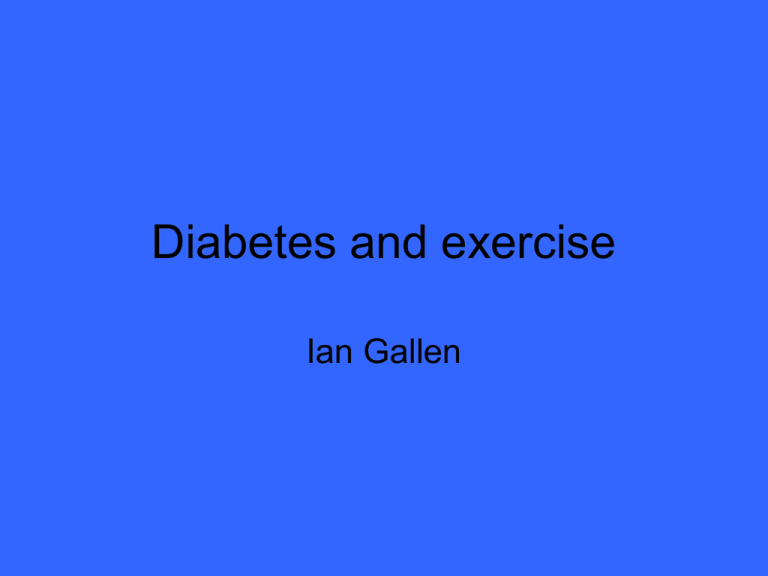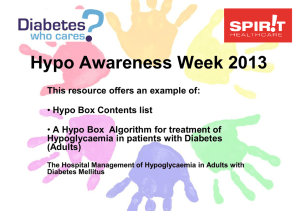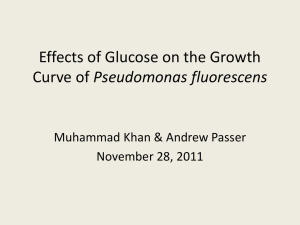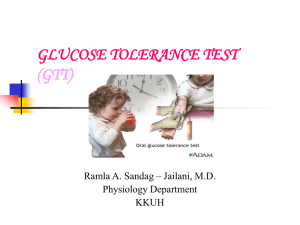
Diabetes and exercise
Ian Gallen
What do we need to know
Effect of exercise on blood glucose
Differences between types of exercise
Timing, type and quantity of carbohydrate
What to do with insulin dose
Nocturnal hypoglycaemia
How to use insulin pump treatment
Glucose metabolism during exercise
Production
Use
m mol/kg/min
60
6
Glucose mmol/l
4.9
4.5
5
4.6
4.55
4.3
3.9
40
4
20
3
0
2
0
50
100
150
0
20
40
60
80
100
Exercise time (min)
McConell et al. 1994
120
What is different about exercise in
diabetes?
• Food storage
– Athletes require high energy intake of high
glycaemic index foods.
• Usually excessive background insulin levels
• Endocrinology of exercise
– Abnormal glucagon response
– Abnormal portal insulin regulation of
gluconeogenesis and ketogenesis
– Impaired catecholamine response
• Diabetic complications
– Autonomic neuropathy/microvascular disease
What Happens to Blood Glucose
in Exercise in Type 1 Diabetes?
22.2
22.2
15/01/2006
16.
7
06/10/2005 (Thu)
Glucose - mmmol/L
mmmol/L
16.7
11.1
Exercise
5.6
11.1
10.0
Exercise
5.6
3.9
0.0
0.0
03:00
06:00
09:00
12:00
15:00
18:00
21:00
03:00
00:00
06:00
09:00
12:00
15:00
18:00
22.2
24/11/2005
Aerobics
mmmol/L
16.7
Cycling
11.1
5.6
Data from
Buckinghamshire
Hospitals Diabetes
Sports clinic
0.0
03:00
06:00
09:00
12:00
15:00
18:00
21:00
00:00
21:00
00:00
Trends in Glucose Production and Use in
T1DM During Prolonged Aerobic Exercise
Glucose use
Glucose
production
Blood glucose
Counter-regulatory
hormone response
Meal
60 min training run
Trends in Glucose Production and Use in
T1DM During Short Intense Exercise
Blood glucose
Glucose
production
Counter-regulatory
hormone response
Meal
30 min exercise
Ian Gallen
Glucose use
Rest
Effect of high or low intensity exercise on
blood glucose in T1DM
Blood glucose and metabolite response
during exercise in T1DM
Glucose levels during and following different
forms of exercise
Aerobic first
Resistance first
Aerobic first
Resistance first
Hypoglycaemia is frequent following aerobic
and resistance training
Effects of exercise on blood
glucose
• Aerobic exercise causes blood glucose to fall
rapidly
• Anaerobic exercise cause blood glucose to rise
• Aerobic exercise increases risk of nocturnal
hypoglycaemia
• Intermittent high intensity exercise protects
against hypoglycaemia during exercise, but is
more likely to cause nocturnal hypoglycaemia
• Team sports have variable effect on glucose
depending on position and intensity of play
Carbohydrate support
Why not just start with a high glucose?
Some mathematics
• Available free glucose space is 20% lean
person total weight
• 1mm/l measured glucose is 0.18g free
glucose or total 2.5g in 70 kg person
• Thus raising bg to 15mmol/l, will only
provide 25g readily available glucose.
• At 60%VO2 max glucose oxidation typically
130 μmol/kg/min.
• Thus approximately 2g/min or 12 minutes!
Capillary Blood Glucose Concentration (mg/dL)
Effect of Carbohydrate Ingestion on the Glycaemic
Response of Type 1 Diabetic Adolescents During Exercise
350
CHO 8%
CHO 10%
300
66.5 g
250
200
Strategy 2
Taking extra glucose whilst exercising
“Using the mouth to do the liver’s job”
150
100
55.3 g
50
*
*
0
-15
0
15
30
Time (min)
Exercise
Data are means ± SD; *p<0.05.
Perrone C, Laitano O, Meyer F. Diabetes Care. 2005;28:2537–2538.
45
60
(0)
(30)
Recovery
(60)
75g Isomaltulose or dextrose before exercise in T1DM
West et al, 2011
Strategies for Glucose
Replacement During Exercise
Glucose 20 g 20 g 20 g
Glucose Concentration (mM)
10 mM
5 mM
Glucose 60 g
10 mM
5 mM
90 minutes aerobic exercise
Insulin dose adjustment
5
4
3
2
1
0
-1
-3
-4
-5
5
4
3
2
1
0
-1
Baseline plasma
glucose (mmol/L)
LP 100% = 8.8 ± 0.55
LP 50% = 6.1 ± 1.3
-2
-3
-4
-5
0
B
Change from baseline in plasma
glucose (mmol.L)
Exercise at 25% VO2 max for 60 min
% Dose
% Dose *
reduction
reduction
Exercise
intensity
30 minmeal
of
60 min of
Reducing
pre-exercise
insulin
Time (minutes)
Time (minutes)
exercise
exercise
(% VO2max)
*
Baseline plasma
glucose (mmol/L)
LP 100% = 10.7 ± 0.7
LP 50% = 9.4 ± 0.8
-2
A
Change from baseline in plasma
glucose (mmol.L)
Exercise at 50% VO2 max for 30 min
30
60
90
120
150
180
0
Exercise at 75% VO2 max for 30 min
25
5
4
50
3
75
0
-1
*
Baseline plasma
glucose (mmol/L)
LP 100% = 8.5 ± 1.3
LP 25% = 6.8 ± 1.1
-2
-3
60
90
120
-4
150
180
25
50
5
4
75
3
2
*
1
75
-
0
-1
210
Exercise at 50% VO2 max for 60 min
50
2
1
30
B
Change from baseline in plasma
glucose (mmol.L)
Change from baseline in plasma
glucose (mmol.L)
A
Baseline plasma
glucose (mmol/L)
LP 50% = 8.7 ± 1.0
LP 25% = 6.0 ± 1.4
-2
-3
-4
-5
-5
0
30
60
90
120
150
0
180
30
60
90
120
Time (minutes)
Time (minutes)
Ian Gallen
Data are means ± SEM; *p<0.05 by repeated measures using ANOVA; LP: lispro.
Rabasa-Lhoret R et al. Diabetes Care. 2001;24:625–630.
150
180
210
Hypoglycaemia seems to be more common with Glargine than
either NPH or Detemir
Nocturnal hypoglycaemia
Biphasic response in glucose requirement with exercise
Increased glucose up take during exercise,
but also late after exercise
Responses of glucose infusion rate (mg/kg{middle dot}min) (A), difference in glucose infusion rate (GIR) between
exercise and rest studies (mg/kg{middle dot}min) (B), rate of carbohydrate oxidation (mg/kg{middle dot}min) (C), and
rate of lipid oxidation (D) to exercise (solid lines) and rest (dashed lines) studies
McMahon, S. K. et al. J Clin Endocrinol Metab 2007;92:963-968
Skeletal muscle GLUT-4 gene expression before (0), immediately after (Post),
and 3 h after (3 hrs) exercise at ~40% (Lo) or ~80% (Hi) peak pulmonary oxygen
consumption
Kraniou, G. N. et al. J Appl Physiol 101: 934-937 2006;
doi:10.1152/japplphysiol.01489.2005
Copyright ©2006 American Physiological Society
Delayed hypoglycaemia CGMS following exercise in T1DM
The complex interaction between
hypoglycaemia and exercise
• Exercise markedly increases muscle insulin sensitivity by
increasing GLUT4 transporters1
– Effect from 6-12 hours post exercise lasting 48 hours.
• Prior hypoglycaemia impairs counter-regulatory
response to exercise, and this is proportional to the level
of hypoglycaemia2.
• Prior exercise impairs the counter-regulatory response to
hypoglycaemia2.
• The counter-regulatory response to exercise is relatively
preserved in women following hypoglycaemia3.
•
1 Thorell A, Hirshman MF, Nygren J et al. Exercise and insulin cause
GLUT-4 translocation in human skeletal muscle. Am J Physiol Endocrinol
Metab 1999;277:E733-41.
2 Galassetti P, Tate D, Neill RA et al. Effect of antecedent hypoglycaemia
on counterregulatory responses to subsequent euglycaemic exercise in
type 1 diabetes. Diabetes 2003;52:1761-9.
3 Galassetti,P.; Tate,D.; Neill,R.A.; Morrey,S.; Wasserman,D.H.; Davis,S.N. Effect of sex on counterregulatory
responses to exercise after antecedent hypoglycemia in type 1 diabetesAmerican Journal of Physiology Endocrinology & Metabolism.2004, 287(1):E16-24,
AN10-551A
Insulin infusion pumps
• Enables normal basal insulin to
be markedly reduced or
suspended whist performing
exercise.
• with rapid post exercise
increase in insulin to deal with
post exercise glycogenic peak.
• and lower post exercise
nocturnal basal rate with
intermittent exercise patterns.
• The gold standard for serious
athletes where practical.
Prevention of Hypoglycemia During Exercise in Children
With Type 1 Diabetes by Suspending Basal Insulin
Glucose Concentration (mg/dL)
200
150
100
50
Basal insulin continued
Basal insulin stopped
0
Baseline
Rest #1
Rest #2
Rest #3
Ian Gallen
End
Post 15
Black dots denote mean values; Boxes denote median, and 25th and 75th percentiles.
The Diabetes Research in Children Network. Diabetes Care 2006;29:2200–2204
Post 30
Post 45
Blood glucose with 1 hour of exercise
at 50% VO2 MAX
Progress towards an artificial Pancreas?
Combination CSII/CGMS
Automatic low glucose infusion suspend during exercise
Automatic low glucose infusion suspend during exercise
Are there any other strategies?
• Sympathomimetics
• Endogenous sympathetic stimulation
The 10-s Maximal Sprint:
Bussau, et al Diabetes Care. 2006. 29, 601.
Caffeine (5mg/kg) and Blood Glucose
During Prolonged Exercise
‡ Glucose 20g given in 2 subjects
20
*
18
Placebo
Glucose (mmol/L)
16
*
Caffeine
14
*
12
n=5
10
8
6
‡
4
Exercise
2
50%
0
-30
0
70% VO2 max
10
20
30
Time (min)
Ian Gallen
Gallen IW, et al. Diabetes Care. 2010;Abstract 1184−P
40
70
Summary of Clinical Strategies to Maintain
Glycaemic Control With Exercise
Strategy
Advantages
Disadvantages
Reducing preexercise
bolus insulin
Reduces hypoglycaemia during
and following exercise; reduces
CHO requirement
Needs preplanning; not helpful for
spontaneous exercise or for late
postprandial exercise
Reducing preexercise
basal insulin
As above
As above, causes pre- and late
postexercise hyperglycaemia
Taking extra CHO
with exercise
Useful for unplanned or
prolonged exercise
May not be possible with some
exercises; not helpful where weight
control important; easy to overreplace
causing hyperglycaemia
Pre- or postsprint
exercise burst
Reduces hypoglycaemia during and
following sports
Effect limited to shorter and less
intense exercise
Insulin pump therapy
Offers flexibility and rapid change in
insulin infusion rates postexercise
Expensive; may not be practical
for contact sports (eg, rugby/
football/judo)
Reducing basal insulin
postexercise
Reduces nocturnal hypoglycaemia
May cause morning hyperglycaemia
Lumb A., Gallen I.W. Curr. Opin. Endo. Diab and Obesity. 2009 16
www.runsweet.com
Ian Gallen









